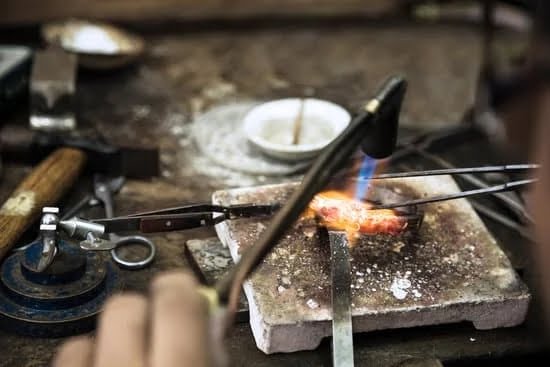Are you wondering how to inventory handmade jewelry? Inventory management is crucial for the success of handmade jewelry businesses, as it helps ensure that you have the right materials and products on hand to meet customer demand. In this article, we will explore the importance of inventory management for handmade jewelry businesses and provide valuable insights into organizing, tracking, and controlling your inventory effectively.
When it comes to handmade jewelry, there are different types of inventory to consider, including raw materials, work-in-progress items, and finished products. Managing these categories effectively is essential for maintaining a streamlined production process and meeting customer orders in a timely manner. We will discuss the different types of inventory for handmade jewelry and how to organize them efficiently.
In addition to understanding the types of inventory for handmade jewelry, it’s important to establish proper storage and labeling techniques. Organizing your inventory plays a significant role in streamlining operations and preventing errors. We will delve into choosing the right storage system and labeling techniques to ensure that your handmade jewelry inventory is well-organized and easily accessible when needed.
Types of Inventory for Handmade Jewelry
When it comes to managing the inventory for your handmade jewelry business, it’s crucial to have a deep understanding of the different types of inventory you need to keep track of. The three main types of inventory for handmade jewelry businesses include raw materials, work-in-progress, and finished products. Each type requires specific attention and management in order to ensure smooth operations and production.
Firstly, raw materials are the foundation of your handmade jewelry pieces. This includes beads, gemstones, metals, wires, and any other materials you use to create your jewelry. It’s important to keep an accurate count of these raw materials to avoid running out during production or over-ordering supplies that may result in unnecessary costs.
Secondly, work-in-progress inventory refers to the partially completed jewelry pieces that are in the process of being made. This can include half-finished necklaces, earrings waiting for their final touches, or bracelets being assembled. Proper organization and storage of work-in-progress inventory can help streamline your production process and ensure that no piece gets lost or overlooked.
Lastly, finished products inventory consists of the completed handmade jewelry pieces that are ready for sale or distribution. These are the items that will be showcased on your website, in retail stores, or at craft fairs. Keeping track of your finished products is crucial for fulfilling customer orders promptly and accurately.
Understanding how to inventory handmade jewelry involves effectively managing all three types of inventory – raw materials, work-in-progress items, and finished products – in order to maintain a successful and efficient business operation.
Organizing Your Inventory
When it comes to managing inventory for your handmade jewelry business, one of the key aspects is organizing your inventory. This involves choosing the right storage system and labeling techniques to ensure that you can easily locate and track your raw materials, work-in-progress, and finished products.
The first step in organizing your inventory is to define a clear storage system. This can include shelves, bins, drawers, or cabinets – the key is to have a designated place for each type of inventory item.
For example, raw materials such as beads, wires, and gemstones should be stored separately from finished products such as necklaces, bracelets, and earrings. In addition to this, using clear containers or transparent bags can make it easier to visually identify the items without having to open each container.
Labeling techniques also play a crucial role in organizing your handmade jewelry inventory. Each item should be clearly labeled with details such as item name or description, quantity, and date of arrival. This not only helps in quickly identifying items but also enables efficient tracking of inventory levels. Whether you use handwritten labels or printed tags, the key is consistency and clarity in labeling all inventory items.
Proper organization of your handmade jewelry inventory not only makes day-to-day operations more efficient but also ensures that you can accurately track stock levels for timely production and fulfillment of orders. By choosing the right storage system and implementing effective labeling techniques, you can streamline your inventory management processes and focus on growing your business.
| Storage System | Labeling Techniques |
|---|---|
| Shelves, bins, drawers | Clear containers or transparent bags |
| Designated place for each type of item | Details such as item name or description, quantity, date of arrival |
Inventory Tracking Methods
When it comes to managing the inventory of handmade jewelry, one of the key decisions is choosing between manual and digital inventory tracking methods. Both approaches have their advantages and drawbacks, and it’s essential for handmade jewelry businesses to weigh their options carefully.
Manual inventory tracking involves recording inventory levels, movement, and other relevant information by hand. This can be done using physical logs, spreadsheets, or even pen and paper. While manual tracking may seem relatively simple and cost-effective, it can be time-consuming and prone to errors. Additionally, manual tracking may not provide real-time visibility into inventory levels, making it challenging to make informed business decisions.
On the other hand, digital inventory management systems offer a more efficient and accurate way to track handmade jewelry inventory. With digital systems, businesses can use specialized software to automatically track inventory levels, monitor stock movements, and generate detailed reports. These systems often integrate with other business functions such as sales and purchasing, providing a holistic view of the entire operation.
In deciding between manual and digital inventory tracking methods for handmade jewelry, businesses should consider factors such as the volume of products, complexity of operations, budget constraints, and long-term growth plans. While some businesses may initially opt for manual tracking due to its simplicity, many eventually transition to digital systems as they expand. Ultimately, the choice between manual and digital inventory tracking methods will depend on the unique needs and goals of each handmade jewelry business.
By understanding how to inventory handmade jewelry with both manual and digital methods in mind will allow owners to choose what’s best suited for their operations in order help them efficiently manage their inventory needs over time as their businesses evolve.
Inventory Management Best Practices for Handmade Jewelry Businesses
Inventory management is a crucial aspect of running a successful handmade jewelry business. Keeping track of raw materials, work-in-progress, and finished products is essential for ensuring smooth operations, meeting customer demand, and maximizing profitability. In this section, we will discuss some best practices for managing inventory effectively in the handmade jewelry industry.
Establishing Clear Inventory Control Procedures
One of the first steps in efficient inventory management is to establish clear control procedures. Regular audits, stock counts, and updating inventory records are essential to ensure accuracy and prevent stockouts or overstock situations. By conducting periodic reviews of your inventory and making adjustments as needed, you can maintain optimal levels of raw materials and finished products.
Utilizing Technology and Tools
In today’s digital age, utilizing technology can greatly enhance the efficiency of inventory management for handmade jewelry businesses. Barcode scanning systems can streamline the process of tracking items in and out of your inventory, reducing the likelihood of human error.
Additionally, investing in inventory management software tailored to small businesses can provide real-time visibility into your stock levels, sales trends, and purchasing patterns. E-commerce platforms also offer features that allow for seamless integration with your inventory system, enabling better control over online sales and stock synchronization.
Adapting to Seasonal Trends
Seasonal trends and demand fluctuations play a significant role in the handmade jewelry industry. Being mindful of these patterns is crucial when managing your inventory. During peak seasons or special occasions such as holidays or festivals, it may be necessary to increase production and stock levels to meet heightened demand. Conversely, during slower periods, adjusting your inventory levels accordingly can help minimize excess stock that ties up valuable resources.
By implementing these best practices and staying abreast of industry trends and technologies, handmade jewelry businesses can effectively maintain their inventory to support their operations while delivering value to their customers consistently.
Establishing Inventory Control Procedures
Importance of Regular Audits
Regular audits are essential for any handmade jewelry business to maintain accurate inventory records. These audits involve physically counting and verifying the actual quantity of raw materials, work-in-progress items, and finished products in stock against the recorded amounts. By conducting regular audits, businesses can identify discrepancies, prevent stockouts or overstock situations, and ensure that the inventory aligns with the sales demand.
Implementing Stock Counts
Stock counts refer to the process of physically counting the items in inventory at a specific point in time. For handmade jewelry businesses, it is important to schedule routine stock counts to reconcile the actual quantities on hand with what is recorded in the inventory system. This process helps in identifying any discrepancies such as pilferage, shrinkage, or inaccurate recording of transactions.
Updating Inventory Records
Accurate and up-to-date inventory records are crucial for effective inventory management. As handmade jewelry businesses receive new shipments of raw materials, complete work-in-progress items, or sell finished products, it is important to promptly update the inventory records.
This includes recording all transactions that impact the inventory levels such as purchases, production activities, and sales. By maintaining accurate inventory records, businesses can make informed decisions regarding reordering raw materials, managing production schedules, and fulfilling customer orders in a timely manner.
By implementing these procedures and maintaining accurate inventory records through regular audits and stock counts for your handmade jewelry business can help you avoid costly errors like overstocks or stockouts while meeting customer demands effectively.
Dealing With Seasonal Trends and Demand Fluctuations in Handmade Jewelry Inventory
Handmade jewelry businesses often experience seasonal trends and fluctuations in demand due to various factors such as holidays, fashion trends, and special occasions. It is important for jewelry makers to anticipate these fluctuations in order to effectively manage their inventory and meet customer demand. Here’s how to inventory handmade jewelry to address seasonal trends and demand fluctuations.
First, it is crucial to analyze past sales data and research upcoming trends in the jewelry market. By understanding the seasonal patterns of your handmade jewelry sales, you can better forecast demand and adjust your inventory levels accordingly. For example, if Valentine’s Day consistently results in a spike in sales for your romantic-themed pieces, you can plan ahead by increasing production or stocking up on inventory in anticipation of this peak season.
Additionally, consider diversifying your product offerings to cater to different seasonal trends and events. This could involve creating specific collections for holidays like Christmas or Halloween, as well as tapping into popular fashion styles that vary from season to season. By diversifying your inventory based on seasonal demands, you can appeal to a wider customer base and capitalize on emerging trends.
Lastly, leverage e-commerce platforms and social media channels to promote and sell your handmade jewelry during peak seasons. With the right marketing strategies in place, you can generate buzz around your products and drive sales during high-demand periods. Furthermore, utilizing technology such as inventory management software can help streamline the process of tracking sales data and adjusting inventory levels based on real-time demand.
| Inventory Management Tips | Data |
|---|---|
| Analyze Sales Data | Understand past patterns and forecast demand |
| Diversify Product Offerings | Create specific collections for holidays and fashion trends |
| Leverage Technology | Utilize e-commerce platforms and inventory management software |
Utilizing Technology and Tools for Effective Handmade Jewelry Inventory Management
When it comes to managing inventory for a handmade jewelry business, utilizing technology and tools can greatly improve efficiency and accuracy. One of the most valuable tools for inventory management is barcode scanning.
By implementing a barcode system, you can easily track and manage your inventory levels, reduce human error, and streamline the process of updating inventory records. Barcode scanning also makes it easier to conduct regular audits and stock counts, ensuring that your handmade jewelry business always has an accurate picture of its inventory.
In addition to barcode scanning, investing in inventory management software can revolutionize the way you track and manage your handmade jewelry inventory. Inventory management software offers features such as real-time tracking, automated stock alerts, and customizable reporting tools. This kind of software can provide valuable insights into your inventory levels, sales trends, and product performance, allowing you to make informed decisions about purchasing raw materials and managing finished products.
Furthermore, e-commerce platforms play a crucial role in effective handmade jewelry inventory management. Whether you sell your products through your own website or third-party marketplaces, integrating your inventory management system with your e-commerce platform can streamline order fulfillment processes and ensure accurate stock levels across all sales channels. By syncing your online sales with your inventory data in real time, you can avoid overselling products and provide better customer service.
Overall, leveraging technology and tools for effective handmade jewelry inventory management is crucial for the success of your business. By implementing barcode scanning, investing in inventory management software, and utilizing e-commerce platforms, you can optimize your operations, reduce costs, and improve customer satisfaction.
Conclusion
In conclusion, proper inventory management is crucial for the success of handmade jewelry businesses. By understanding the types of inventory, organizing and tracking methods, best practices, and utilizing technology and tools effectively, businesses can maintain control over their stock and meet customer demand. The importance of establishing inventory control procedures such as regular audits, stock counts, and updating inventory records cannot be overstated. These procedures help businesses stay on top of their inventory levels and prevent shortages or excess stock.
Moreover, dealing with seasonal trends and demand fluctuations in handmade jewelry inventory requires flexibility and foresight. By analyzing past sales data and staying updated on industry trends, businesses can adjust their inventory levels accordingly. This adaptability is essential for meeting customer demand while avoiding unnecessary costs.
In essence, by implementing the strategies discussed in this article on how to inventory handmade jewelry, businesses can improve efficiency, reduce costs, enhance customer satisfaction, and ultimately achieve greater success. Proper inventory management not only ensures that businesses have the right products available at the right time but also contributes to overall business growth and profitability.
Frequently Asked Questions
How Do I Make a Jewelry Inventory?
Making a jewelry inventory involves documenting each piece of jewelry you own, including details like the type of jewelry, materials used, and any distinguishing features. You can create a digital inventory using a spreadsheet or specialized software, or opt for a physical inventory by writing down the details in a notebook or on index cards.
How Do You Keep Jewelry in Your Inventory?
Keeping jewelry in your inventory requires proper storage to avoid damage or loss. Consider investing in jewelry organizers like trays, boxes, or display cases to keep your pieces organized and protected. Store fine jewelry in individual pouches or boxes to prevent scratches and tangles, and ensure that costume jewelry is stored separately to avoid tarnishing.
How Do You Label Jewelry Inventory?
Labeling jewelry inventory is essential for easy identification and retrieval. Use clear and concise labels on storage containers or pouches, including information like the type of jewelry (earrings, necklace, ring), material (gold, silver, gemstone), and any specific details like size or style.
If using a digital inventory system, include clear and descriptive labels for each item to quickly locate them when needed.

Welcome to my jewelry blog! My name is Sarah and I am the owner of this blog.
I love making jewelry and sharing my creations with others.
So whether you’re someone who loves wearing jewelry yourself or simply enjoys learning about it, be sure to check out my blog for insightful posts on everything related to this exciting topic!





